Garden screening ideas – 24 ways to beautify boundaries and create privacy
Choose garden screening ideas to keep a yard private, conceal poor views, and divide the space in style


Garden screening ideas perform a whole host of functions. They can stop neighbors and passersby seeing into the yard. But they might also be needed to hide a less than lovely view from the space.
Screening can also make different areas of the yard distinct when backyard landscaping ideas include creating different zones, leading to a richer design that slowly unfolds rather than becoming apparent in a single glance.
They offer design opportunity in themselves, too, using interesting materials, plants including climbers, trees and shrubs, and even garden buildings and, here, we’ve collected ideas to inspire.
Garden screening ideas
In an ideal world we wouldn't need garden screening ideas – our yards would be private sanctuaries where we can spend time gardening, entertaining and relaxing away from prying eyes.
But being overlooked is the reality for most people living in urban areas with houses on either side, or with yards immediately backing onto an outside space.
You may also want to use screening as an important element of your garden design to create a sense of a journey through the space.
1. Double up boundary planting

Creating more privacy in a garden overlooked by the surrounding houses needs thinking through carefully. Sometimes ‘double wrapping’ the space is the most effective option.
‘In this garden we dealt with the issue of being overlooked in two ways,’ says designer Charlotte Rowe. ‘We planted a row of pleached hornbeam trees and tall hornbeam hedging along the far end boundary. Then we planted a second small group of Cercidiphyllum japonicum (katsura) trees further inside the garden for additional screening.’
This arrangement achieved the objective of dealing with the garden being overlooked as well as creating an added sense of depth and enclosing a ‘secret garden’ sunk on a lower level to add a little mystery to the design.
Trees contribute height, structure and a focal point but it’s important to choose the best trees for privacy and screening. The elegant Cercidiphyllum japonicum used in this yard is a medium-sized tree with a lovely light, delicate canopy that’s perfect for smaller spaces. The heart-shaped leaves unfurl bronze in spring and gradually take on yellow and orange tones in fall, adding interest throughout the seasons.
2. Draw the eye into your own space
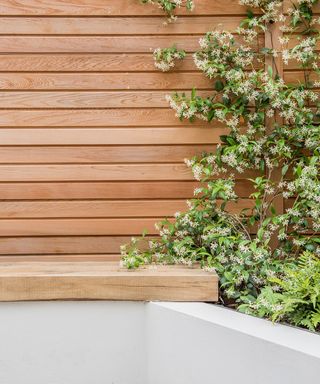
It’s worth upgrading fences to a high spec finish like cedar if yours are quite prominent but not up to scratch. Climbers will add softness and much-needed greenery to a fence, as well as year-round structure if you choose an evergreen variety. Another alternative is to attach modern trellis panels which plants will soon scramble over. Both ideas turn the focus inwards.
‘If your garden is overlooked the trick is to make it as cozy and inviting as possible, to focus attention on your own space rather than neighboring properties,’ says designer Catherine Clancy. ‘Clad the boundaries with greenery, using climbers like evergreen star jasmine (trachelospermum jasminoides).’ Plant shrubs generously to make the garden as lush as possible, which will help by adding a lovely distraction.
Another clever idea is to position your seating area so that you are looking in towards your own house rather than out. If space is at a premium consider built-in seating like this and include lots of planting to further enhance a sense of privacy.
3. Layer the planting
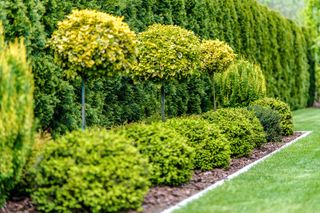
A combination of trees and shrubs can create an impressive layered look that also makes a space feel more private. Here, the depth as well as the height of the planting makes the backyard a secluded location.
A formal arrangement like this, which includes topiary, requires maintenance, so if you can’t dedicate sufficient time to clipping, opt for a more informal combination of privacy plants instead.
There are also plenty of ornamental grasses for screening that can help achieve this look.
4. Use living walls to screen boundary walls

The use of living wall ideas for garden screening ideas can have a two-fold benefit – hiding unsightly or plain boundary walls, as well as adding another planting dimension to your yard.
‘Using vertical garden ideas offers the opportunity to make the most of every space in your garden – there is a plethora of possibilities, and living walls are especially useful in small gardens, courtyards and balconies, to use every perspective,’ says gardening writer Leigh Clapp.
Living walls are planted more densely than a garden bed and can provide a tapestry of color and form. 'Use reliable, long-living, disease resistant plants that are light with shallow roots, as they will have restricted root space. For a year-round effect select mostly evergreens, then highlight with seasonal color,' adds Leigh.
5. Garden screening ideas as design features
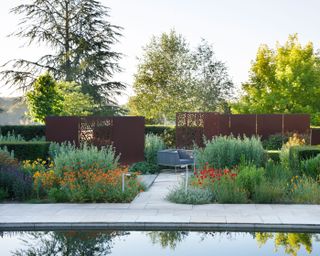
The use of screens to loosely partition and create ‘open’ rooms, artfully divided, is a design trick employed by garden designer by Anthea Harrison in this beautiful country garden.
Decorative laser-cut and solid Corten steel screens gently restrain the garden’s more formal elements, while funnelling the view towards specific focal points or garden vistas, and also act as features in themselves.
6. Divide and screen areas with arbors and arches
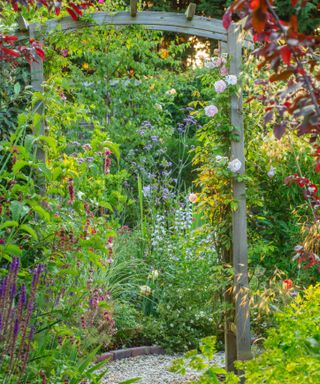
Arbors, arches and tunnels can become lovely focal points adorned in profusely flowering vines or flowering climbers. They also act as garden screening, dividing different areas of the garden, and indicating an entry point to a separate garden room which can have its own discrete feel and planting palette.
An arbor nestled among dense, colorful planting creates an illusion of space, which can be particularly effective in small garden ideas.
7. Create a garden journey with screening planting
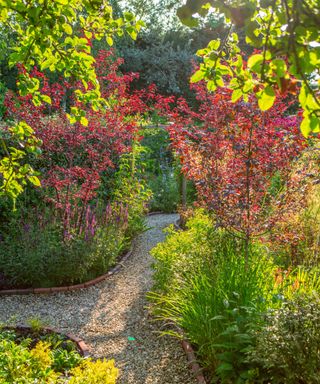
If there is enough room, divide areas with planted barriers for a feeling of a journey through the garden to hidden places.
You can create an illusion of space with planting. Curving pathways running between a profusion of flowers and plants can be more interesting and create mystery, generating a surprise around every turn.
8. Disguise unsightly areas
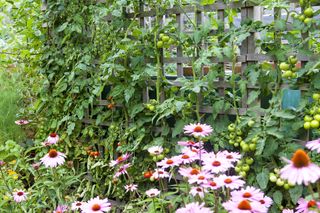
The most practical use of garden screening is to hide out of view the less sightly elements of your garden, such as storage or composting areas.
‘Most small gardens in particular have to be practical as well as visually appealing. They often serve as a room outside as well as a garden.
'Creating attractive storage outside can contribute hugely towards making your garden a truly unique space and one that lends itself to use all year round,’ explains garden designer Kate Gould.
There is a wide choice of garden screening ideas to disguise a less attractive corner or element of the garden, depending on where it is located and the surrounding area. A decorative trellis panel smothered in evergreen climbers, or edibles can serve both a beautiful and practical purpose.
9. Use architectural salvage
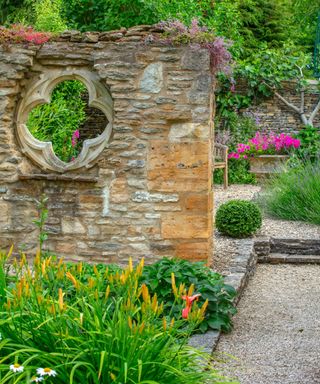
Architectural salvage opens up a wealth of possibilities, and reclaimed sections of stone walls or follies can be reused as screens to create divisions between garden rooms.
This folly stone wall includes a quatrefoil window through which you can glimpse a further seating area of the garden.
10. Create a garden screening structure
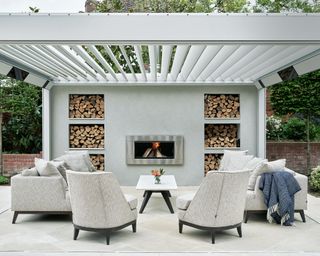
‘Creating a sense of enclosure, cosiness and privacy is a big contribution which an overhead structure, such as a pergola can make,’ explains garden designer Barry Chambers.
‘Added to this, it could be concealing you from neighboring windows, or with plant cover and panels or trellises, a screen can also provide shelter from the breeze,’ he adds.
'If the best spot in your backyard for a seating area is overlooked, a smart structure is the quickest and lowest maintenance way to create garden screening,' says Homes & Gardens Editor in Chief Lucy Searle.
'The smart pergola roof idea above is in the spirit of the garden screening idea I have in my own city garden, the sunniest part of which is overlooked by my neighbors. By using angled louvers, you can keep out prying eyes and create dappled shade, which is perfect for a seating or dining area. It's also a wonderful way to create a focal point in a large space.'
11. Add color and privacy with a pretty awning

If you are looking for patio cover ideas that offer color, shade and screening, the solution may not be planting, but a garden awning. Those that extend outwards above your head by more than a 6ft can offer some privacy, but you can also find awnings that extend down to the ground on either side that will provide garden privacy and screening from the weather, too.
12. Choose trellis for subtle screening
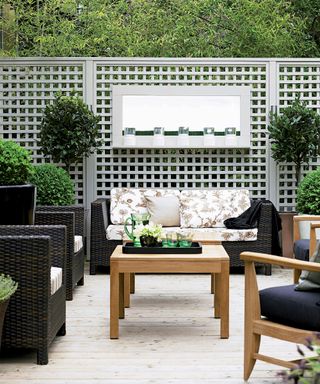
'Adding trellis to the top of a fence will of course offer extra screening and privacy in a backyard, but there are other ways to use trellis ideas cleverly,' says H&G's garden expert Rachel Crow.
'One of those ways is perfectly illustrated above, where the trellis provides screening that isn't entirely opaque. The benefit of this is that you can either simply divide a backyard by zone, for example, a kids' play area from an adults' seating area, while still being able to see into the other area. Or, you can make the most of a "borrowed view", perhaps a beautiful woodland to the back of your yard, which can help to make a small garden look bigger.
13. Plant lush shrubs for privacy
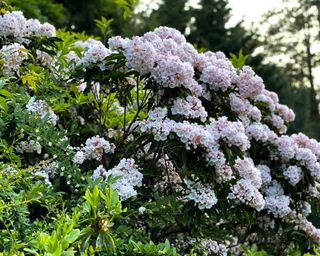
Whether you are starting a planting scheme from scratch or want to add garden screening ideas to an existing garden, choosing the best shrubs for privacy is one of the best ways to please both garden users and wildlife.
These include laurel, as above, holly, rhododendron, privet, laurel, photinia, honeysuckle and forsythia, some of which have made our best fast-growing shrubs list, too – a bonus if you want garden privacy ideas fast.
14. Hide a structure with planting

A tall wall, whether brick or rendered blocks, is a great way to increase garden screening and security at the same time, but it can look stark and uninviting, which may not be the effect you want to create. The best way to disguise this type of garden privacy device is to match it with evergreen climbers, which will soften the structure, provide shelter for wildlife and – if you plant flowering climbers – color and scent, too.
15. Plant ornamental grasses

While some people like to spend as much time as possible in their gardens year round, others tend to see their outdoor space as a spring/summer attraction.
If you are in the latter camp then tall, airy ‘see-through’ plants like bamboos or ornamental grasses around a seating or sunbathing area will provide sufficient screening, and still allow light to filter through without the need for more heavy duty garden fence ideas.
Likewise, a medium-sized feature tree planted in the sightline of a bedroom will provide privacy for your house. Just don’t plant it too close to the building itself. An upright ornamental cherry would make an attractive and effective shield, as would an ornamental pear such as Pyrus ‘Chanticleer’.
16. Create garden screening with trees

Planting trees is the best way to create a hidden spot. But if you are worried that having trees will mean sacrificing light, worry not – there are two techniques that will help.
By cutting a few of the bigger branches right back to the trunk, you will allow more light through and prevent vigorous regrowth, which is also important to preserve space in small gardens.
You can also try something called ‘lifting your tree’s skirt’, which simply involves removing lower foliage, as in the garden above.
17. Create tall boundaries with hedges

Finding effective garden screening ideas can seem daunting, but that doesn’t mean you have to give in and accept that your every move will be observed forever. There are plenty of ways to improve privacy without resorting to tall fences or towering garden wall ideas.
A good place to start is with your boundaries. Some backyards are defined by low walls or ‘see-through’ fences that offer very little cover. The ideal solution is to establish the best privacy hedges, using fast-growing species.
Deciduous hedges are best planted from late fall to early spring using bare-rooted plants. Evergreen hedges, using container grown plants, should be planted from mid to late spring.
18. Build a sheltered structure on an exterior wall

A dining or lounge space close to the house can take inspiration from these porch ideas with the addition of a covering structure attached to an exterior wall.
‘Every garden has those places you automatically drift to, as well as natural areas of shade, light and privacy,’ explains award-winning landscape and garden designer Sarah Eberle.
‘Climbing plants for pergolas and walkways might seem like a romantic option that also offers an element of privacy, but the truth is that many quickly grow out of control, damaging supporting structures, so it’s important to choose non-vigorous species. Pillar roses work well and so does clematis, but this needs to be paired with something evergreen, such as Akebia quinata.’
19. Go underground
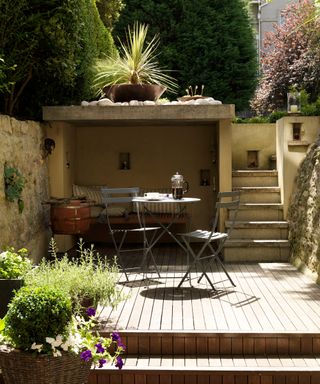
Sunken gardens make great retreats and are especially useful garden privacy ideas when designing urban plots or looking for long garden ideas, where boundary fences may cast unwanted shade.
Lowering a terrace by just 18 to 20in (46 to 51cm) makes it easier to create a sense of privacy with garden screening ideas, such as planting or awnings; if you want to go lower, ask a landscape architect to check the water table level and advise on drainage.
In a sloping garden, carve out terraces and create an outdoor room on the lowest level.
20. Enforce border controls
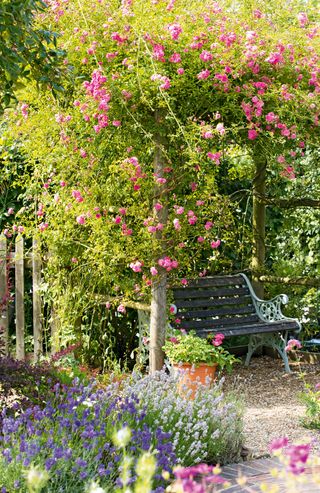
Lining paths or patios with perennials, grasses and bamboos is a good way to hide seating areas from view.
Plants that die down in winter offer privacy during summer when you are relaxing outside, but will not block out light during the rest of the year.
By placing seats strategically, you may find flowers and foliage do not need to be very tall to make an effective screen.
21. Opt for a cover up
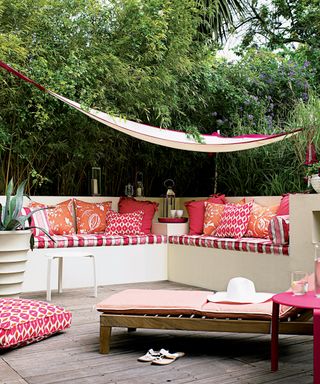
Garden shade ideas and garden screening ideas can be synonymous. A sail shade suspended over a seating area will not only block direct views from upper storey windows, but will also give protection from sunlight and showers.
The frame can be adorned with climbers, to enhance the enclosed feel. Check that they will grow tall enough to cover the structure, and fix wires to the uprights for the stems to cling to.
22. Build a summerhouse or pavilion
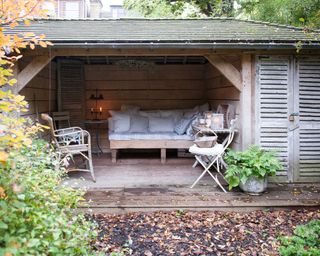
Position a summerhouse or pavilion so that it backs onto the backyard boundary where it is most overlooked; the building's roof and walls will create a visual barrier and a private space in front.
Concealing the structure behind trees or large shrubs can increase the sense of seclusion, especially if it is reached by a journey through the garden via charming garden path.
Where there is no space for a building, alternative privacy ideas such as an arbor seat next to a boundary will have a similar effect.
23. Install a water feature for noise screening
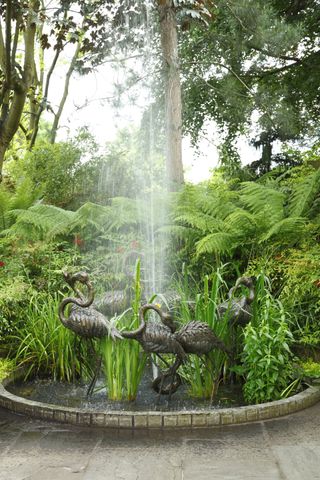
Although water feature ideas may not be the first thing that springs to mind when you think of garden screening, screening noise in a garden is crucial for a tranquil ambience.
Water spouts and fountains help to drown out the sound of traffic and noisy neighbors, and ensure your conversations are not easily overheard.
The most effective water features produce just the right level of sound – soothing rather than irritating – and form an integral part of the garden design.
24. Step into the woods
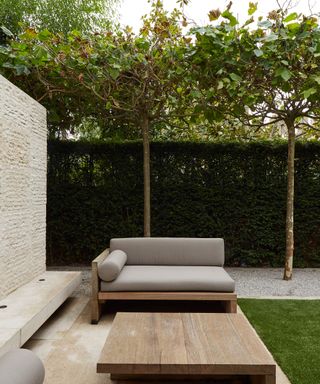
Trees offer unlimited scope for providing privacy. A small copse planted at the end of a garden will form a quiet refuge. In a large, open space, use ornamental trees to screen off a sheltered area with a dramatic view – and edge it with hedges or low walls.
In smaller gardens, three or four trees with slim trunks, such as Himalayan birches, are the best trees for a small garden because they create a snug wooded retreat.
How can I get privacy in my garden?
Garden zoning is one of the most effective garden screening ideas.
Consider the sightline – where are you trying to get privacy from? Then block these areas off to create private spots.
To do this, play with planting – layers of tall grasses help to softly zone a private area in your garden. Screening helps, too. Choose a material which sits in your garden style, perhaps bamboo, metal or wood.
If you're trying to block off sight from above, then adding a pergola is a great way to achieve privacy. Rush matting at the top, or growing climbers such as ivy or clematis, will allow light to filter in but not wandering eyes.
How can I stop neighbors overlooking my garden?
Tempting though it may be to block yourself off from the world, high panel fencing often isn’t the answer. For starters, erecting a fence more than 6ft (2m) high will not only annoy your neighbors but may require planning permission. Secondly, doing so will likely shade out some of your garden, and reduce your planting options.
So instead of reaching for the fencing, try and make the best use of what you already have. Take a stroll around your garden to identify where any privacy issues might lie. Is there any part of your plot where you cannot be seen at all? If so, ask yourself whether you are currently making the best use of this precious space. It’s also worth considering exactly when privacy is most important to you.
Ultimately, with a bit of thought, a few simple techniques and clever use of garden privacy ideas, you can enjoy your time in the garden without an audience – and will not have to sacrifice light to do so.
What plants make the best privacy screens?
Use these raised garden bed ideas around the perimeter of your space. Filled with tall plants like bamboo, ornamental grasses and Carex pendula they will naturally create privacy. Like net curtains, they’ll provide a screen between you and the outside world without casting too much shade.
Sign up to the Homes & Gardens newsletter
Decor Ideas. Project Inspiration. Expert Advice. Delivered to your inbox.

Jennifer is the Digital Editor at Homes & Gardens. Having worked in the interiors industry for a number of years, spanning many publications, she now hones her digital prowess on the 'best interiors website' in the world. Multi-skilled, Jennifer has worked in PR and marketing, and the occasional dabble in the social media, commercial and e-commerce space. Over the years, she has written about every area of the home, from compiling design houses from some of the best interior designers in the world to sourcing celebrity homes, reviewing appliances and even the odd news story or two.
- Rachel Crow
- Sarah WilsonContent Editor
-
 Dark colors never looked so calming in this family home filled with moody hues
Dark colors never looked so calming in this family home filled with moody huesThis Pennsylvania home is a masterclass in using color to create cozy, welcoming spaces with just a hint of drama
By Karen Darlow Published
-
 Decluttering myths debunked – 11 rumors making your life 10 times harder
Decluttering myths debunked – 11 rumors making your life 10 times harderProfessional organizers debunk the 10 most common decluttering myths that make organizing a home more difficult than it needs to be
By Chiana Dickson Published